Thingvellir National Park
By Michael Chapman
Translating to Fields of Parliament, Þingvellir National Park is the birthplace of Icelandic democracy
Thingvellir National Park
By Michael Chapman
Translating to Fields of Parliament, Þingvellir National Park is the birthplace of Icelandic democracy
What is Thingvellir?
Þingvellir is a national park and UNESCO World Heritage site in South Iceland. With a total size of 240 square kilometres, Þingvellir remains an important place nationally due to its valued part in history and vital contributions to Icelandic art, literature and culture.
Locals and visitors alike flock to Þingvellir for its natural beauty, a unique blend of volcanic lava rock, lush vegetation and encircling mountains. Today, the park is part of South Iceland’s famous Golden Circle sightseeing route alongside the sputtering pools of Geysir geothermal springs and the powerful 32-metre high waterfall, Gullfoss.
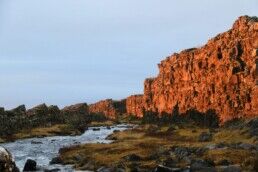
For this article’s purpose, we will be focusing on Þingvellir, which tends to be the first site visitors choose to make a stop. Anyone who has visited this area can attest to its odd and ancient ambience. When a light mist rolls over its gnarled pyroclast, when the wind howls ghostly across its glacial ravines and caverns, it is frankly impossible not to feel moved by your surroundings.
Because of these reasons, Þingvellir attracts thousands of visitors each year, all of whom to choose to experience the national park in their own style. Some decide that visiting in summer is best, opting for more daylight hours beneath the Midnight Sun to see Þingvellir’s hidden corners. Others choose the winter, entranced by the promise of auroras and fewer crowds.
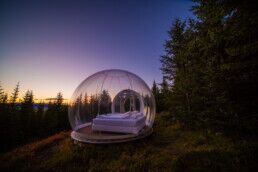
Regardless of which season you visit, we recommend booking a Golden Circle bubble tour, as not only will you discover Þingvellir, Geysir and Gullfoss, but also spend the night in a transparent bubble, hidden away in the quiet Icelandic wilderness. Our bubble locations fit perfectly on your route, and provide a depth of solitude and affinity with nature that no other accommodation choice can rival.
The History of Thingvellir National Park
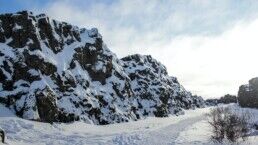
Icelandic history and culture are rich with Þingvellir’s influence. Without hordes of people congregating at this site throughout the years, Iceland would not have existed as we know it today. In this sense, Þingvellir is akin to the Athenian’s Pnyx, or the Roman Senate, and has arguably contributed as much to the development of parliamentary democracy.
Þingvellir translates to “Fields of Parliament” because Iceland’s first government, the Althingi, formed therein 930 AD. In the years prior, new settlers had had to make do with local assemblies, but as the island population grew, bolstered by Norsemen and Celts, the need for greater governance quickly became apparent.
Þingvellir was chosen as the new assembly site by Grímur Geitskör (nickname; Goatshoe) who decided on several factors. Not only did the area have high cliff sides perfect for speaking to crowds—notably, the Lögberg, or Law Rock—but attendees could also reach it from the island’s most populated regions.
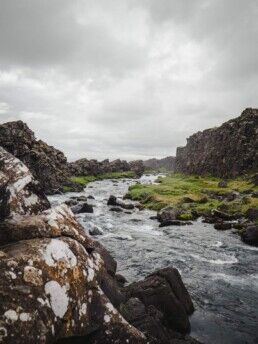
On top of that, Þingvellir’s landowner had recently been found guilty of murder, and thus had his property stripped of him. While this might sound a lot like government conspiracy, technically, there was no government yet in existence—say about that what you will!
Throughout the Icelandic Commonwealth, different clans would gather at Þingvellir to discuss the passing of legislation, trade goods and see justice enacted. It was also a time of festivities and socialising; entertainers, farmers and artisans would gather to make plans and share stories, setting the foundation for a shared language and culture.
Another important event at Þingvellir occurred In 1000 AD, less than a Century after the Althingi’s formation. It would be the new government’s first test, and one that famously took three days and three nights to solve. Of course, we are talking about the sensitive matter of state religion.
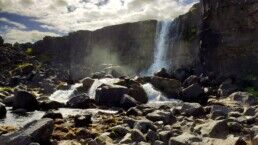
Having brought a belief in the Norse Pantheon from Norway, Icelanders soon faced pressure from overseas trading partners to convert en masse from Paganism to Christianity. This ban was because most Europeans were disturbed by the idea of doing business with heathens, who they considered barbaric and uncivilised, and many ecclesiastical nations outright banned the practice.
Eventually, the lawspeaker Þorgeir Þorkelsson deliberated long enough, concluding that Iceland would be a Christian country. However, he added a caveat; those who wished to continue worshipping the Pagan Gods were permitted to do so as long as their reverence remained secret. It is for this reason, perhaps, that many Icelanders today have faith in a mixture of beliefs, adopting elements of both ideologies into an uneasy, yet unique marriage.
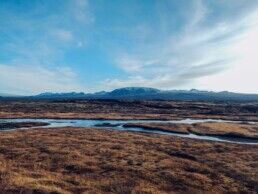
Speaking of religious matters, there is a peculiar contribution to the diaries of medieval Icelandic scholar, Snorri Sturluson, that describe a party of 80 armed men visiting Þingvellir on a private matter. Some have speculated that these mysterious guests might have been the Knights Templar on a mission to hide the Holy Grail. Though this might sound a preposterous notion, Snorri left no explanation as to why they arrived in the first place.
Þingvellir National Park was founded in 1930 to celebrate the 1000th anniversary of the Althingi’s formation. Such establishment felt necessary after Þingvellir’s re-emergence as a national symbol during the 19th Century. However, it was only in 2004 that the park became a designated World Heritage Site after expanding its borders to protect the biodiversity of the greater area.
PLAN YOUR JOURNEY
Travelling to Iceland?
Check our overnight tours with a driver guide that includes a one night stay in a bubble.*Starting from ISK 74.900 per person
The Geology and Nature of Thingvellir National Park
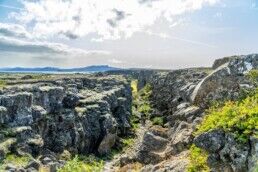
As one might expect, it is not only Þingvellir’s history that makes visiting here fascinating and worthwhile. Every rock and cliff-edge, every fissure and boulder tells a story that begins with this island’s violent formation around 17 million years ago.
Known as the Mid-Atlantic Ridge, Iceland sits on a boundary between two tectonic plates, the Eurasian and the North American, and is thus easily influenced by primordial elements and the movement of the earth. While this might sound abstract and, dare we say, academic, this neovolcanic zone can be observed at the national park through the exposure of its tectonic plates.
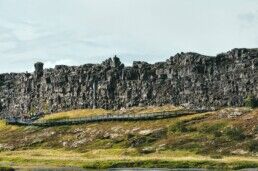
What lies in between is an ancient field of dried magma, one that becomes emerald-green with moss in the summer, and stark white in winter. With stark contrasts abound, visiting this national park is an entirely different experience depending on the season; perfect for repeat guests looking for something new on a second visit to the land of ice and fire.
Spring and summer visitors will find Þingvellir blooming with plant life. There are over 170 different vegetation species to be found, including just short of half the flora found in the country. Wildlife lovers can also discover over 50 bird species, counting goldeneye and harlequin ducks, and even the rarely-spotted white-tail eagle.
What to see and do in Thingvellir National Park in Iceland
Your first stop will likely be at Þingvellir’s Visitors Centre, which is a great place to buy maps and brochures, information booklets, souvenirs and snacks. Friendly park rangers will layout what you can see and do in Þingvellir, as well as point you towards spots that have taken your interest. For instance, fans of popular culture will want to find the precise locations where filmmakers shot HBO’s Game of Thrones in Þingvellir.
Almannagja gorge and viewpoint
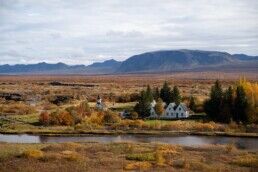
Besides the Visitor’s Centre, you will find an observation point atop the Almannagja gorge. From here, you will have panoramic views over the national park, which is as beneficial to nature-lovers as it is budding landscape photographers. The park’s quintessential aspects can be seen in detail, from the picturesque white church, Þingvallakirkja, to Silfra Fissure and even the Eurasian tectonic plate, decipherable as a dark, wavy line in the far distance.
A gravel walkway leads from the observation point parallel to the North American tectonic plate, meaning you’ll always have a rocky cliffside towering over the side of you. En route, you will notice several display boards that go into more detail about Þingvellir’s history and will cross a bridge over the infamous drowning pool.
Known to locals as Drekkingarhylur, this largely-unimpressive patch of water was utilised by state-executioners as a means of disposing of women guilty of adultery and infanticide. Looking down on the drowning pool, it’s disturbing to associate its untroubled waters with cruel and antiquated punishment, while also evident that history’s darkest chapters make for fascinating subjects.
As much could be said for Lögberg rock, where it is thought over 70 people were sentenced to die, or even Höggstokkseyri, the bank of the river where beheadings took place. While the trail might seem filled with morbid sites, it is fascinating to realise how far Iceland has come from the dark and challenging days of the settlement period.
Öxarárfoss waterfall
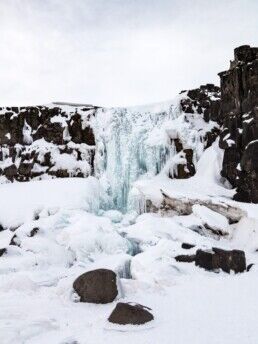
Öxarárfoss waterfall (Axe Falls) is one of the main sights of Þingvellir National Park and can be found at the end of Almannagja gorge. It flows as part of the lake-to-lake river, Öxará. At only 13 metres high, Öxarárfoss is not the tallest waterfall in Iceland, nor the widest or most powerful. Still, it possesses an innate, natural beauty that is captivating when seen firsthand.
Interestingly enough, it is thought that Öxarárfoss is not entirely natural, but is instead the result of a historical water diversion. Geological records seem to indicate a dried riverbed west of the waterfall’s location, which we can assume was altered to supply the gathering crowds at Þingvellir with fresh drinking water.
During the winter, Öxarárfoss is known to freeze completely, making for unbelievable photo opportunities. Ice climbers have even managed to ascend the frozen falls, though this is not readily available to most visitors.
Snorkelling and scuba diving at Silfra fissure
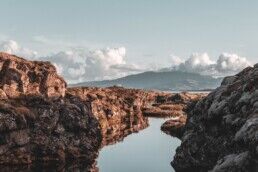
Renowned the world over for its dramatic underwater scenery, frigid water temperature and amazing 100-metre visibility, Silfra Fissure in Þingvellir National Park doubles as Iceland’s most popular snorkelling and scuba diving spot. Available in both winter and summer, this aquatic adventure is thrilling and beautiful in equal-measure, and makes for the perfect side activity on a Golden Circle trip.
While snorkelling and scuba diving typically put one in mind of hot tropical beaches, vibrant fish-life and handsome instructors, things could not be more different in Iceland. To protect from a water temperature that remains 2-4°Celsius (35-39°Fahrenheit) throughout the year, guests will have to adorn themselves in a thick thermal drysuit, as well as neoprene hoods, gloves and boots.
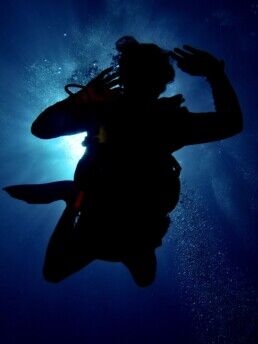
While the equipment might feel bulky, it will keep you warm and comfortable throughout the experience. Aside from that, the drysuit helps with buoyancy, keeping you rooted at the surface. As you enter the ravine, it’s best to gently push into the water, keeping your mask below the surface and the snorkel-tip above it. From there, your face will quickly go numb—trust us, it’s not as bad as it sounds—and the current will do the rest, gently sweeping you and the other snorkelers along from one beautiful section to another.
The first significant part of the ravine, aside from the entrance point, is also its most expansive; Silfra Hall. After making your way over a strip of shallow rocks, you will float out into a vast and open underwater canyon. As you progress along the fissure, the sapphire-blue majesty of Silfra Cathedral will reveal itself, complete with glimmering algae, shifting silica and the odd baby fish that has ventured too far from the lake.
It is important to note that snorkelling at Silfra Fissure is only available for comfortable and competent swimmers. Scuba divers will have to provide evidence of a drysuit certification, as well as logged drysuit dives.
Lake Thingvallavatn
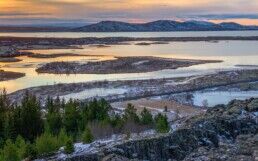
Lake Þingvallavatn is the largest natural water body in Iceland and can be first witnessed when driving from the capital to the national park. Enclosed by gently steaming mountains and hills, Þingvallavatn can look lush and stunning on summer days, while downright alien and eerie in winter.
There are not many fish in Lake Þingvallavatn, but brown trout, arctic charr and three-spined stickleback count as the exception. Their presence in the lake is of interest to scientists, especially those studying how fish species adapt to new environments over 10,000 years of isolation. For instance, it is believed that Þingvallavatn’s brown trout are the largest found globally because of the lake’s constant influx of fresh water.
Those experienced scuba diving with a drysuit also have the opportunity to check out Davíðsgjá, or David’s Crack, which is considered the darker, deeper and more dramatic version of nearby Silfra Fissure. This site requires a shore entrance from a pebble-strewn bay, as well as a short swim to your descent point. Given the visibility matches that of Silfra, divers will have incredible views over Davíðsgjá’s phenomenal landscape, and will likely spot far more fish than otherwise.
The Icelandic Friendship Forest
Alright, while the Icelandic Friendship Forest lacks the drama of most attractions found across this country, it is a novel and often beautiful stop during your time in Þingvellir, if only for a quick five minutes. Attractions of a quieter, more subtle character can be quite the relief on a journey filled with so much epic scenery and action.
In a country that’s mostly barren of trees, the Icelandic Friendship Forest does not do much in the way of reforestation efforts. Classifying it as a forest at all seems wildly over-enthusiastic, in fact. Instead, this minute patch of woodland is a symbolic location, made up of the many trees and plants that have been donated to Iceland by overseas governments.
If you are interested in world affairs, nature and diplomacy, you’ll find this site just off the main road before entering the west of the national park.
How to travel to Thingvellir National Park from Reykjavik?

Þingvellir National Park is approximately 47.4 kilometres from Iceland’s capital, Reykjavik, translating to what is roughly a forty-minute drive. This trip comes as a welcome commute; one of vast and epic landscapes, where human-made structures of the city quickly give way to sparse hills and wild open country.
How much time should I spend at Thingvellir National Park?
How much time you choose to spend at Þingvellir National Park comes down to personal preference. However, we would push you to take several hours discovering all this beloved site has to offer. Your time in Iceland is valuable and rare, so maximising every second the experience should always be a priority.
Guests partaking in a snorkelling or scuba diving tour in Silfra will need to allot more time in the park. Those experiencing the entire Golden Circle sightseeing route will usually spend around 8-hours appreciating the sights, taking travel times into consideration.
Is there parking at Thingvellir National Park?
Perfect for self-drivers and solo travellers, there is parking on-site at Þingvellir. Valid for the entire day, the parking fee is 750 ISK for cars five seats or less, and 1000 ISK for anything bigger. This fee allows you to park your vehicle in any of the lots around the national park, minus the one used solely by snorkelling and scuba diving operators.
What attractions are nearby to Thingvellir National Park?
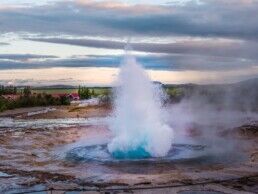
As mentioned previously, Þingvellir National Park is just one stop on the Golden Circle. Two other vital ingredients that make up this 240 kilometre sightseeing route are Geysir geothermal springs and Gullfoss waterfall, both of which offer variety and interest to passing travellers.
Geysir geothermal valley is best known for the lively spectacle that is Strokkur hot spring in mid-eruption. Crowds gather to watch Mother Nature in action; from a small, aquamarine pool, boiling water is routinely blasted up to 20 metres into the air, delighting all those who look upon it. Nearby is the now dormant hot spring, Geysir. While no longer able to fire water as Strokkur does, people will always cherish it for having its name adopted to mean geysers everywhere.
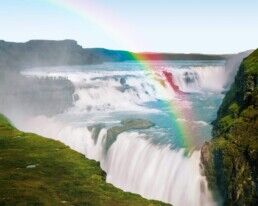
Gullfoss waterfall is surrounded by peaceful farmlands, creating a staggering visual contrast that arrives quite unexpectedly. Camouflaged behind a translucent curtain of water vapour, this awe-inspiring feature draws the eye with its cascade tumbling over two prominent ledges. Observers look on from one of two viewing platforms, easily hypnotised by the sheer power, no less the grandeur, of this mighty waterfall.
There are plenty of other smaller stops found that make for interesting diversions from the Golden Circle. Among the most popular include the volcanic crater, Kerið, Friðheimar tomato farm and the geothermal spas, Laugarvatn Fontana and The Secret Lagoon.
PLAN YOUR JOURNEY
Travelling to Iceland?
Check our overnight tours with a driver guide that includes a one night stay in a bubble.*Starting from ISK 74.900 per person
2 Comments
Comments are closed.

[…] should make a detour to Brúarfoss after a morning spent in Þingvellir National Park so as to best maximise your time on the road. Such proximity to Geysir and Gullfoss makes it an […]
[…] that make up the famous Golden Circle sightseeing route in South Iceland, the other two being Þingvellir National Park and Geysir geothermal […]